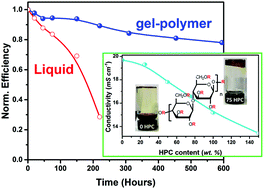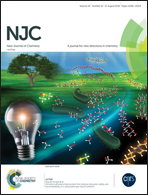Long-term stability of dye-sensitized solar cells using a facile gel polymer electrolyte
Abstract
Herein, we demonstrate a facile low temperature approach to prepare a gel polymer electrolyte (GPE) based on the triiodide/iodide redox couple in a quasi-solid-state dye-sensitized solar cell (DSSC). Only one polymeric agent (i.e., hydroxypropyl cellulose (HPC)) is used for the preparation of a non-volatile GPE system for the standard liquid electrolyte containing 1-methyl-3-propylimidazolium iodide (MPII). The prepared GPE completely penetrates into a TiO2 photoanode at room temperature due to the uniform distribution of Ti, Ru and I elements in the cross-section of the electrode, forming an interpenetrating GPE/TiO2 network to access all dye molecules. The GPE with the optimum HPC : MPII weight ratio shows a high ionic conductivity of 17.8 × 10−3 S cm−1 and a viscosity of 350 cP. The DSSC fabricated using such gel polymer electrolyte shows the best performance and energy conversion efficiency of 7.44%, with a short-circuit current density, an open-circuit voltage and a fill factor of 15.37 mA cm−2, 707 mV and 68%, respectively. The constructed quasi-solid-state cell has long-term operational stability under realistic outdoor conditions, with 90% of the initial device's efficiency after 600 h.



 Please wait while we load your content...
Please wait while we load your content...